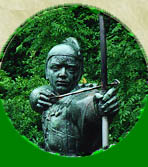
THE MERRY MEN
By Allen W. Wright
Robin Hood is not a lone outlaw but the leader of a trained band of fighters. And it's a good thing too. Robin's a reckless lad sometimes. He'll sneak into Nottingham once too often and get caught by the sheriff. Or he'll pick a fight with the wrong traveller. And when the going gets rough, Robin blows three great blasts on his horn. That's when his Merry Men appear. Some say they are a small group of outlaws. Others say there were 140 or 150 Merry Men in Robin's band. Some tales even say there were 300 stout fellows in the band. Whatever the case, if it weren't for these sturdy yeomen (and yeo-women), Robin wouldn't last a week.
Little John
Maid Marian
Friar Tuck
Will Scarlet
Much the Miller's Son
Alan a Dale
Other Merry Men
The
first thing you should know about Little John is that he is not --
little, that is. Some stories say he was over seven feet tall. Often he
looks like a wild man with a thick beard and dressed in skins.
 The next
thing you should know about Little John is that he is Little,
-- John Little is his real name. However, some say it is really John
Naylor
or le Nailer. It's said he comes from Hathersage in Derbyshire, the
shire
next to Nottinghamshire which was controlled by the same sheriff. His
grave
can be found in a churchyard in Hathersage. Click
here
to see his tombstone , and click here to see a
picture of me alongside his very long grave . The next
thing you should know about Little John is that he is Little,
-- John Little is his real name. However, some say it is really John
Naylor
or le Nailer. It's said he comes from Hathersage in Derbyshire, the
shire
next to Nottinghamshire which was controlled by the same sheriff. His
grave
can be found in a churchyard in Hathersage. Click
here
to see his tombstone , and click here to see a
picture of me alongside his very long grave .
Little
John is Robin Hood's lieutenant, his second-in-command. In the
early ballads, he is nearly as important as his master. John has his
own
adventures. For example, there's the time he entered a Nottingham
archery
contest. The sheriff liked what he saw and hired Little John. Using the
alias Reynold Greenlefe, the outlaw promised to be the worst servant
the
sheriff ever had. By the story's end, Little John encouraged the
sheriff's
cook to join Robin's band and they lured the sheriff into the greenwood
where
he was robbed by Robin Hood. In another ballad, John dresses as a
beggar
and fights three miserly beggars.
He is an
excellent swordsman and archer. In fact, one time Little John
beat Robin in a playful archery contest. Robin refused to pay up and
John
quit his service. Then Robin got captured by a monk's treachery. It was
Little John who organized the Merry Men to trick the sheriff and even
the
king in order to rescue Robin. Once free, Robin Hood apologized and
offered
to make Little John the leader of the band. John refused. No matter how
much they fight, Robin is always the master.
Little
John's best-known weapon is the quarterstaff. He was carrying a
quarterstaff when he first met Robin Hood.
One day
Robin Hood was bored. There hadn't been an adventure in weeks.
And so he left the Merry Men behind and went in search of excitement.
Robin
found it when he came across a stream with a long, narrow bridge. He
started
to cross the bridge. On the other side was a tall stranger who was also
crossing the bridge. Neither would not back down.
Robin
threatened to shoot the stranger, declaring "I'll show you right
Nottingham play!"
The
stranger called Robin a coward. "Well arm'd with a long bow you
stand,/To shoot at my breast, while I, I protest,/ Have nought but a
staff in my hand."
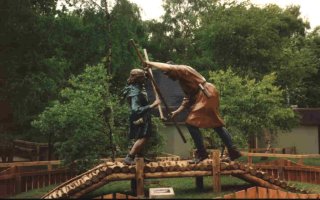 Robin
lowered his bow and went to carve himself a staff. Then, Robin and the
stranger battled each other long and hard. Both were wounded. But
finally, the stranger knocked Robin into the brook. The outlaw was
"floating away with the tide".
Robin
lowered his bow and went to carve himself a staff. Then, Robin and the
stranger battled each other long and hard. Both were wounded. But
finally, the stranger knocked Robin into the brook. The outlaw was
"floating away with the tide".
Thus,
Robin conceded the battle. He climbed out of the water, and blew his
bugle horn. The Merry Men, led by Will Stutely, appeared. Robin's men
threatened to fight the stranger. But Robin stopped them. Robin asked
the stranger if he'd like to join the Merry Men and wear the Lincoln
green clothing of the outlaw band.
The
stranger accepted. And he was baptized into the band by Will Stutely.
To quote again from the ballad,
"This
infant was call'd John Little,"
quoth he.
"Which
name shall be chang'd anon,
The words
we'll transpose, so where-
ever he
goes,
His name
shall be called Little John."
Then,
Little John was dressed in green and took his place in the band.
Click here to read the ballad Robin Hood and Little John.
In some
movies, John loses the fight on the bridge. In the Kevin Costner movie,
John is the original leader of the outlaws, and it's Robin who joins
them and assumes control of the Merry Men after he had won the
quarterstaff duel.
Some modern stories portray Little John as nothing more than a dumb sidekick, but in the earliest tales, he was as crafty as Robin Hood himself. In fact, an old meaning of the word Little was "tricky" or "clever", not small.
In some
tales, Little John is a gentle man. In others, he can be downright
angry and violent. He beheads a monk in one story and shoots the
sheriff
in the back in another. And in one modern story, he even killed a woman
who
spurned him. Thankfully his bad temper is usually not so monstrous.
He might
grumble or argue, but when push comes to shove, Little John is always
there for Bold Robin. You couldn't ask for a more loyal friend.
There's
an old saying that behind every great man is a great woman. Meet Maid
Marian. She is Robin Hood's true love and truly a great woman.
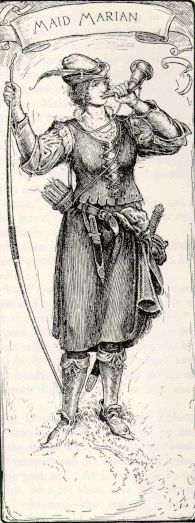 Local
legend says Robin and Marian were married in St. Mary's church in the
village of Edwinstowe. Click here to see a
picture of the church.
Local
legend says Robin and Marian were married in St. Mary's church in the
village of Edwinstowe. Click here to see a
picture of the church.
Marian's
a late-comer to the legend, and she doesn't appear in many of the
traditional ballads. No matter. She has become a very important part of
the legend.
True, she
can be merely a damsel-in-distress. Sometimes she's a Norman
noblewoman, daughter of Lord Fitzwalter or Sir Richard at the Lee, a
knight who was helped by Robin Hood. She meets Robin when he ambushes a
group of Norman knights. However, in other stories, she's a Saxon who's
known Robin since they were children. Other times she is the ward of
the sheriff or Prince John. And her unwanted suitors include the
sheriff, Guy of Gisborne and
even Prince John. Our hero will have to rescue her from these men.
There
are times when Maid Marian is merely the hero's girlfriend. In some
tales
the happy couple refuse to marry until the Merry Men are pardoned,
hence
she is called "Maid Marian".
But
Marian (or Marion, as her name is often spelled) is not always a weak
character in need of rescuing. Even cloistered away in Nottingham, she
acts as a spy, passing information to the rogues in Sherwood. The
sheriff only suspects her ties to Robin Hood. And in a time when women
were forced into unwanted marriages, Marian chose to love Robin. She'll
also speak her mind.
And in
many stories, she's an even stronger character. Sometimes she lives as
an outlaw with Robin and is as good an archer and swordsman as he is.
In these stories, she's usually just called Marion or Marian. The maid
part
of her name is dropped, or she is called Lady Marion instead.
In one
ballad, she is Robin's childhood sweetheart. Disguising herself
as a male page she heads to the forest to find her outlawed partner.
Unfortunately, when she comes across Robin, he is also in disguise. Not
recognizing each other, they start a fight.
They drew
out their swords, and to
cutting
they went,
At least
an hour or more,
That the
blood ran apace from bold
Robins
face,
And
Marian was wounded sore.
"O hold
thy hand, hold thy hand," said
Robin
Hood.
"And thou
shalt be one of my string,
To range
in the wood with bold Robin
Hood.
And hear
the sweet nightingall sing."
 As
you can see, Marian fought him to a standstill. It was Robin Hood who
called the fight off. When they recognized each other, there was much
rejoicing
and she entered the band. As
you can see, Marian fought him to a standstill. It was Robin Hood who
called the fight off. When they recognized each other, there was much
rejoicing
and she entered the band.
Click here to read the ballad Robin Hood and Maid Marian.
Sadly,
some writers at the end of the 19th century and the beginning of 20th
century weakened Marian. She gets one tiny mention in a classic
children's book. In another book, her fight with Robin ends when she
sees blood and
faints. Yet another says Robin overcame her easily.
Rubbish!
There have always been strong women in history, and some of them were
warriors. I prefer a strong Marion who can beat Robin in a fight.
Marian doesn't take crap from anyone, Robin included.
Recent
writers have restored Marian to her rightful place in the band.
Sometimes she is even the brains behind the Merry Men. In one novel,
it's Marian disguised as Robin Hood who shoots in the famous archery
contest for
the golden arrow.
One young
adult novel says Marian is the "Forestwife", a pagan priestess with
magical healing powers. She is often the mythic Green Woman to Robin's
Green Man.
Don't
underestimate this "Lady Wolfshead"!
Here's
another Merry Man you shouldn't underestimate. Friar Tuck is very
overweight and seems to love food and ale as much as his God. He can be
jolly, foolish, lecherous, an alcoholic, a devout holy man and
sometimes wise. He is also a dangerous opponent.
Just ask
Robin Hood. The outlaw leader was foolish enough to pick a fight with
him.
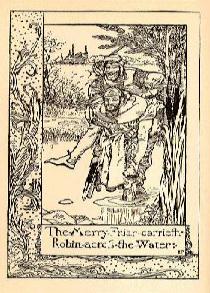 Tuck lived
by a small ford. Robin wanted to cross the river. So, he climbed on
Tuck's back and ordered the friar to carry him across the water. Tuck
did so. But then he forced Robin to carry him back across the water.
Now, Robin climbed onto the friar's back again. But halfway across,
Tuck dumped bold Robin into the water.
Tuck lived
by a small ford. Robin wanted to cross the river. So, he climbed on
Tuck's back and ordered the friar to carry him across the water. Tuck
did so. But then he forced Robin to carry him back across the water.
Now, Robin climbed onto the friar's back again. But halfway across,
Tuck dumped bold Robin into the water.
Then,
they had an archery contest and fought with swords. Tuck won.
Robin
asked a boon. He blew three blasts of his horn and fifty Merry Men
appeared. Tuck asked a favour in return and blew a whistle. Fifty dogs
appeared to fight the Merry Men. (In the play version, Tuck summons
some
men of his own. It's hard to get fifty fighting dogs on the stage.)
But Robin
Hood called the fight off and asked the friar to join his band. Tuck
accepted.
Click here to read the ballad Robin Hood and the Curtal Friar.
It's said
Tuck comes from Fountains Abbey in Yorkshire or Fountaindale in
Nottinghamshire. Click here to see a picture of the river Skell and Fountains Abbey in Yorkshire, supposed site of Tuck and Robin's first meeting. Occasionally his full name is given as Michael Tuck. Sometimes Tuck is
the Sheriff of
Nottingham's chaplain. In some stories, his connection with Robin is
unknown
by the bad guys and, like Marian, he can give secret help to the
outlaws.
In the novel Ivanhoe, Tuck is known as the Clerk of Companhurst and lives at a hermitage with his dogs, his wine and a storehouse of freshly killed venison. When he goes into battle with Robin of Locksley, Tuck discards the hermit's grey robes and dons a Lincoln green uniform. Tuck declares "When I am cased in my green cassock, I will drink, swear, and woo a lass with any blythe forester in the West Riding." He promises to confess his sins to his grey-clad priestly self.
Friar
Tuck isn't in many ballads, but he's still an important part of
the outlaw band.
Will
has a variety of last names -- Scarlet, Scarlett, Scarlock, Scadlock
and
Scatheloke. By one of these names, he's been a member of the Merry Men
since
the earliest tales. (In some versions, Scarlet and Scathelock are
separate
characters.)
 One ballad
says that Robin Hood met a stranger dressed in scarlet silk. Naturally,
they got into an argument. The argument lead to a broadsword fight. The
stranger won, of course.
One ballad
says that Robin Hood met a stranger dressed in scarlet silk. Naturally,
they got into an argument. The argument lead to a broadsword fight. The
stranger won, of course.
Robin
asked what the stranger's name was and where he came from. "In Maxfield
was I bred and born,/ My name is Young Gamwell." Young Gamwell had
killed his father's steward and was exiled to the greenwood. It turned
out that
the stranger is the son of Robin's own sister. That means Will is
Robin's
nephew. But in the same ballad, he is called Robin's cousin. Cousin
used
to mean any close relative beyond the immediate family and so this term
is
still correct. In other stories, Will is Robin's cousin in the modern
sense
-- son of Robin's mother's sister. Sometimes these cousins were
outlawed
together.
When he
joined the band, Gamwell (which is often spelled Gamewell) was
christened Will Scarlet.
Immediately
after he joined the Merry Men one ballad says that Robin
Hood, Little John and Will Scarlet saved a princess from three Turkish
giants. For their good deeds, Robin and his men were pardoned. And the
princess
chose to marry Will Scarlet. Also, Will was reconciled with his father,
the Earl of Maxfield. [Some claim Maxfield is really Mansfield,
Nottinghamshire.]
Will
Scarlet can be a scarlet-clad dandy, obsessed with fashion and even
carrying a rose. Sometimes he is even musical.
But the
early Will Scarlet was as violent and grubby as the other Merry Men.
Some modern versions have returned to that tradition. Will Scathelock
is his real name. Will was a mercenary, but his wife was raped and
murdered by other mercenaries. Calling himself Scarlet, Will murdered
his wife's
killers. This Will Scarlet is hot-tempered and questions Robin's
leadership.
(Check out the picture of Ray Winstone as Will at top. He's the epitome
of the angry Scarlet, and as far from the dandy on the side
illustration
as one can get.)
But
whatever his name or nature, Will is a welcome member of the Merry
Men -- next in importance after Robin and Little John. His advice is
considered valuable.
Some
legends say he was killed by the sheriff's men.
Click here to see his unmarked grave in Blidworth, Nottinghamshire.
Much
is mentioned quite a bit in the earliest stories. Some stories call him
Midge or even Nick the Miller's Son. Sometimes Much and Midge are
different
people.
Originally,
Much was strong enough to carry Little John. And he was
violent enough to behead a monk's page just to keep him quiet.
But
nowadays Much is seen as a young, innocent character who is not too
bright. In one book, he's only 12, the son of an Older Much the Miller
who was murdered by Normans.
 Many
films show Much killing a deer -- a severe offence against the forest
laws. The Norman overlords are about to chop off his hand or burn out
his eyes. That's when Robin interferes and saves the young man. Much
joins
the Merry Men.
Many
films show Much killing a deer -- a severe offence against the forest
laws. The Norman overlords are about to chop off his hand or burn out
his eyes. That's when Robin interferes and saves the young man. Much
joins
the Merry Men.
Another
story makes Much (or Midge, as he was sometimes called) yet another tradesman who was stopped by Robin Hood.
The young miller was carrying a great sack of flour, and Robin
suspected that he might be holding gold in the sack. Much (or Midge)
opened the sack and tossed flour in Robin's face. Then, like so many
people before him,
Much beat the stuffing out of bold Robin. Of course, Robin asked Much
to
join the Merry Men.
Sadly, if
there's a Merry Man who is left out of the stories these days, it is
Much. Even so, he still appears in some tales and is often the youthful
mascot of the band. And perhaps, its soul.
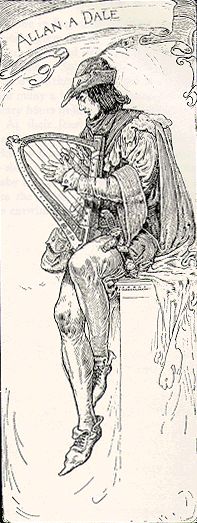
Alan's
only an occasional Merry Man showing up late in the legend. Still he is
popular, sometimes as the narrator of the stories. His name is spelled
a
variety of ways -- Alan, Allen, Allan and Allin. (My own name is Allen,
and so I know just how many ways there are to spell or misspell this
name.)
Robin
came across a happy man in scarlet clothing. Amazingly Robin didn't
start a fight. But the next day, he saw the same man depressed and
unhappy. He stopped the man to ask what was wrong.
Alan was
to marry his true love that very day. But instead, she was given to an
old, cruel, rich knight. The young man said he'd be Robin's servant if
the outlaw could save his true love. Disguising himself as a bold
harper, Robin snuck into the ceremony. He blew on his horn and summoned
the other Merry Men, with Alan a Dale in the lead. They stopped the
wedding, crossing the knight and the bishop. Then, Little John put on
the bishop's clothes
and married Alan and his true love. Other versions have Tuck performing
the
wedding service, which would certainly make it more official.
Click here to read the ballad Robin Hood and Allen-a-Dale.
Alan's
wife has been given different names, although Ellen seems to be the
most common.
There's
an early reference to this tale where it's Will Scarlet's bride who is
rescued. Since both Will and Alan dress in scarlet, they can be
confused. And somtimes both are musicians.
Usually,
Alan doesn't serve the Merry Men as a fighter. Instead he is
a minstrel, providing musical entertainment for the outlaw feasts. Alan
also spins tales of Robin's deeds, spreading the bold outlaw's fame
throughout the land. In most tales, Alan is a master musician. But in
one television show, he's hopelessly tone deaf.
In
many ballads, there are said to be seven score yeomen in the Merry Men.
That's 140 outlaws. So, there are many more Merry Men than just the
major
figures. Sometimes, they are just like unnamed extras in a movie, but occasionally these supporting characters are given names.
Will
Stutely (sometimes just another name for Will Scarlet and sometimes a separate character) is the most common. It's
he who christened Little John into the greenwood band. There's also
a ballad where Robin rescues Stutely.
Gilbert
with the White Hand is nearly Robin's equal in archery, and a
member of his band in one ballad. David of Doncaster is mentioned in
another.
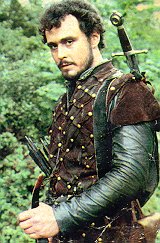 Then,
there are the many tradesmen in the Merry Men. Robin comes across them,
picks a fight and loses. Stop me if you've heard this story before.
Among
these are the tinker Wat O' the Crabstaff, the pedlar Gamble Gold and
the
tanner Arthur a Bland, who is Little John's cousin. George a Greene is
the
pinder of Wakefield in Yorkshire and a star of his own tales.
Then,
there are the many tradesmen in the Merry Men. Robin comes across them,
picks a fight and loses. Stop me if you've heard this story before.
Among
these are the tinker Wat O' the Crabstaff, the pedlar Gamble Gold and
the
tanner Arthur a Bland, who is Little John's cousin. George a Greene is
the
pinder of Wakefield in Yorkshire and a star of his own tales.
There are
almost no women in the classic Robin Hood stories. Alan a Dale's wife
is sometimes a part of the Merry Men, and George a Greene is married to
Bettris. And naturally, there's Maid Marian. In a couple of stories,
Robin's love interest is Clorinda, queen of the shepherdess (a skilled
archer
and huntswoman) -- although a few have said this was merely Marian in
disguise. Some modern writers have wisely added a few more women to the
outlaw band. These include Bold Jane Downey and Will Scarlet's sister
Cecily. In a 2001 TV movie, Robin and Marian's daughter Gwyn joined the
aging Merry Men.
But the most important addition to the Merry Men is a Muslim, either a Saracen or a North African Moor. The original one, Nasir, is a deadly ex-assassin in Robin of Sherwood, a 1980s television series. The movie Prince of Thieves has the wise philosopher Azeem and a 1997 had a black martial artist named Kemal among the band. A 2006 TV series featured Djaq, a sometimes cross-dressing Muslim woman join the gang. She has some of Azeem’s scientific know-how. It looks like the Arab Merry Man, with his ever-changing name and personality (and now gender), is here to stay
Note: The basic information on this page reflects the biography or life story of the Merry Men as the end result of centuries of storytelling. It is only a small part of a much larger site with information on the Robin Hood legend. For a more advanced look at how the legend has changed over time, please visit the Wolfshead through the Ages section. For information on the candidates for a historical inspirations for the Merry Men, in particular Friar Tuck, check out the Search for a Real Robin Hood section.
If you're interest in Robin Hood Books, DVDs, etc - check out the Recommended Reading and Viewing section.
NEXT: Sherwood, Nottingham and Barnsdale (The Locations of the Legend)
BACK: Robin Hood (First article in the Beginner's Guide)
|
